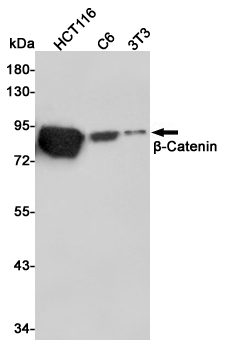-
Product Name
Anti-beta Catenin (5D6) Mouse antibody
- Documents
-
Description
beta Catenin (5D6) Mouse monoclonal antibody
-
Tested applications
WB
-
Species reactivity
Human, Mouse, Rat
-
Alternative names
Beta catenin ;Beta-catenin ;Cadherin associated protein ;Catenin (cadherin associated protein) antibody; beta 1 antibody; 88kDa ;Catenin beta 1 ;Catenin beta-1 ;CATNB ;CHBCAT ;CTNB1_HUMAN ;CTNNB ;CTNNB1 ;DKFZp686D02253 ;FLJ25606 ;FLJ37923 ;OTTHUMP00000162082 ;OTTHUMP00000165222 ;OTTHUMP00000165223 ;OTTHUMP00000209288 ;OTTHUMP00000209289. antibody
-
Isotype
Mouse IgG1
-
Preparation
Antigen: Purified recombinant human β-Catenin protein fragments expressed in E.coli.
-
Clonality
Monoclonal
-
Formulation
PBS(pH 7.4) containing with 0.03% Proclin300 and 50% glycerol.
-
Storage instructions
Store at 4°C short term. Store at -20°C long term. Avoid freeze / thaw cycle.
-
Applications
WB: 1/1000
-
Validations

Western blot detection of β-Catenin in HCT116,C6 and 3T3 cell lysates using β-Catenin mouse mAb(dilution 1:1000).Predicted band size:92kDa.Observed band size:92kDa.
-
Background
Swiss-Prot Acc.P35222.Key dowstream component of the canonical Wnt signaling pathway. In the absence of Wnt, forms a complex with AXIN1, AXIN2, APC, CSNK1A1 and GSK3B that promotes phosphorylation on N-terminal Ser and Thr residues and ubiquitination of CTNNB1 via BTRC and its subsequent degradation by the proteasome. In the presence of Wnt ligand, CTNNB1 is not ubiquitinated and accumulates in the nucleus, where it acts as a coactivator for transcription factors of the TCF/LEF family, leading to activate Wnt responsive genes.Involved in the regulation of cell adhesion. The majority of beta-catenin is localized to the cell membrane and is part of E-cadherin/catenin adhesion complexes which are proposed to couple cadherins to the actin cytoskeleton.
Related Products / Services
Please note: All products are "FOR RESEARCH USE ONLY AND ARE NOT INTENDED FOR DIAGNOSTIC OR THERAPEUTIC USE"
